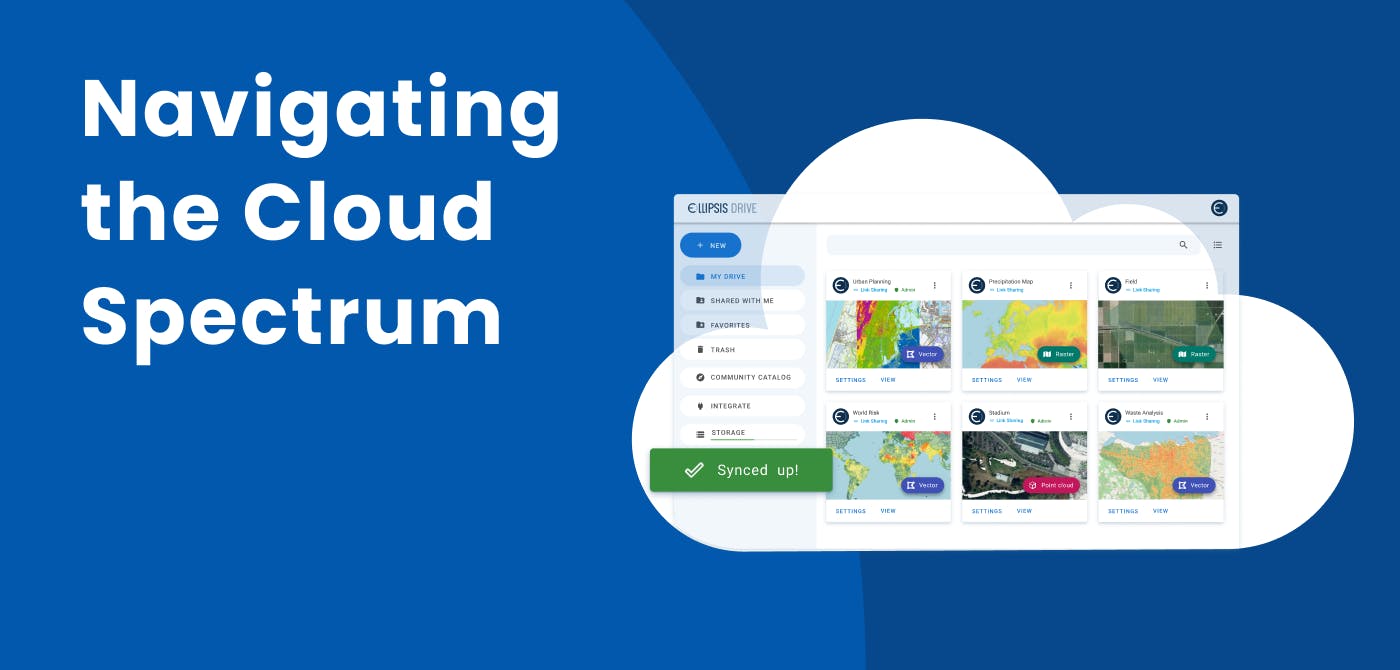GIS
Fusing The Boundaries of Spatial & Non-Spatial Data Management (PART 2)

Contents
Introduction
In the first part of this series, we established how spatial data is woefully siloed. And how both the existing options (building in-house and buying a commercially serviced spatial data infrastructure) are sub-optimal in more ways than one. We also touched on the challenges arising due to siloed spatial datasets and came to a unanimous conclusion - It is worth fusing the boundaries of spatial and non-spatial data management systems.
While the previous article focussed on why fusing spatial and non-spatial data is important, this article focuses on the ‘how’. How do businesses go about fusing the boundaries of spatial and non-spatial data management systems?
We roped in our CTO, Daniel van der Maas who demonstrated how Ellipsis Drive (ED) answers the above question. Let’s get right into it.
Linking Spatial and Non-Spatial Data Management Systems
“Ellipsis Drive strives to be a very compatible solution. General data management systems can act as a file manager below Ellipsis Drive. ED can take care of activated spatial data content while still keeping the originals secure in your bucket.” said Daniel.
Upon launching Ellipsis Drive on top of an existing data bucket, files are added to the Ellipsis Drive index and ED will act as your bucket manager from that moment on. This means you can take advantage of full ED functionality without any data migration, manual restructuring or re-indexing. ED then gives you the ability to:
- Instantly render spatial data in endpoints of your choice such as ArcGIS, QGIS, PowerBI and Folium via simple plugins
- Access your spatial data as OGC web services, tiles services, and via STAC compliant API
- Scale from 1MB to infinity at log-n performance on all fronts (processing, rendering, sharing)
Daniel also addressed the issue of dealing with spatial data that already existed in the general data management systems. He said, “It is possible to retain the raw files in the general database (like Databricks) and simply use Ellipsis Drive as an activation software on top of it. So for example you can quickly read a vector layer on ED, do your analysis and write back your results to ED that can be streamed onto a web map application, data science pipeline, you name it. This provides a low threshold proof of concept and ensures business continuity.”
Business Impact of Merging Spatial & Non-Spatial Data
Deploying Ellipsis Drive on top of your existing data bucket shortens the distance between technical teams (comprising of data engineers, scientists, analysts, GIS experts) and key decision makers within your organization. Technical teams can use pipelines they build on top of Databricks or Snowflake, write those results on Ellipsis Drive and make them available in a dashboard for decision makers. The key here is that the dashboard is automatically served by Ellipsis Drive via a standard protocol. So the technical team doesn’t have to manually configure the dashboard each time a new iteration is created. Data published on ED is already compatible with map view softwares. This makes it much simpler for technical teams to serve data to dashboard users (i.e. decision makers).
Here is what this does for teams that use Ellipsis Drive:
- Time Efficiency: 95%+ time saved on data management and transformation by automating spatial data ingestion, structuring and integration.
- Data Querying: 100X faster data querying through high performance spatial data use for data scientists, modelers, and developers compared to existing workflows.
- Scalability: 100% scalable spatial data ingestion and management pipeline for existing and new 2D/3D spatial data vendors
- Seamless Access to Sample Libraries: Instant access to data to high performance spatial data to feed your modeling and apps.
- Interoperability: Instant spatial data transmission from one team or organization, to another.
Final Thoughts
The above transformation eliminates data wrangling and management grunt work. Let's look at how that can benefit your team members.
Data Scientists - 70% faster project completion rate for data scientists. By automating data preparation and wrapping the API with Python and R packages, your data science team can focus on analysis right away while using tools of choice.
Developers - Developers can flexibly render vector and raster data in software with just a single line of code. The result is that all spatial data are made available on a drag/drop basis or simple command line basis for high performance and interoperable use by modelers, data scientists, engineers and analysts via Python, R, API, GIS software and Power BI.
GIS Specialists - GIS experts can set up a fully scalable and interoperable cloud-native GIS database that structures and indexes your spatial data in a single upload. As a result of this, GIS specialists are unburdened from database creation and maintenance, thus freeing up their time to produce jaw-dropping analytics.
In conclusion, merging spatial and non-spatial data management systems through solutions like Ellipsis Drive can significantly streamline data workflows across various teams. By eliminating manual data wrangling and enabling seamless interoperability, businesses can achieve greater efficiency, scalability, and faster project completion. Whether it's for data scientists, developers, or GIS specialists, this integration empowers teams to focus on higher-level tasks, driving impactful insights and innovation.
Would you be interested in a Proof-of-Concept with Ellipsis Drive? Get in touch with our Head of Sales for a detailed discussion of your use case.
Liked what you read?

Subscribe to our monthly newsletter to receive the latest blogs, news and updates.
Take the Ellipsis Drive tour
in less than 2 minutes'
- A step-by-step guide on how to activate your geospatial data
- Become familiar with our user-friendly interface & design
- View your data integration options

Related Articles

Navigating the Cloud Spectrum: From Generalist to Specialized, and the Perfect Middle Ground
The modern cloud ecosystem spans a wide spectrum of offerings, from general-purpose infrastructure to highly specialized platforms built for domain-specific tasks. At one end, generalist clouds provi
5 min read

Unlocking the Potential of Data: Comparing Tabular and Non-Tabular Protocols
The world of data is a complex landscape and each year, the complexity of that landscape grows exponentially. A combination of new data capturing technology, data processing technology and demands fo
6 min read

Understanding the importance of GIS in Urban Planning
Cities are robust places filled with life, but before it becomes a cosmopolitan paradise, plenty of ever-evolving complexities are happening behind the scenes to bridge the gaps and create an area spa
3 min read